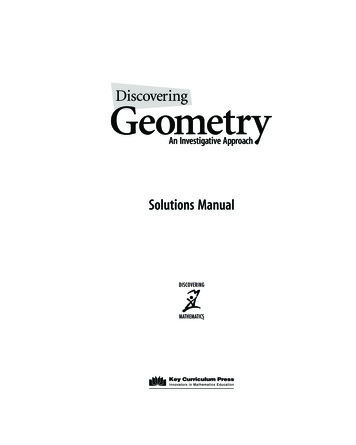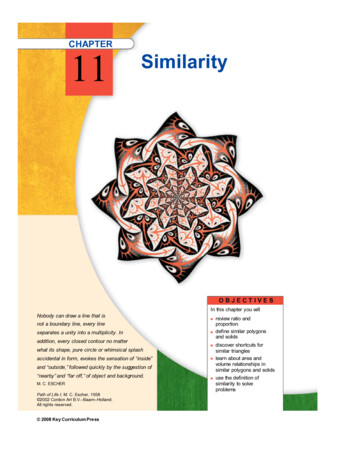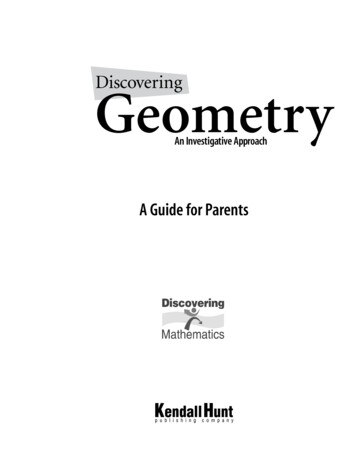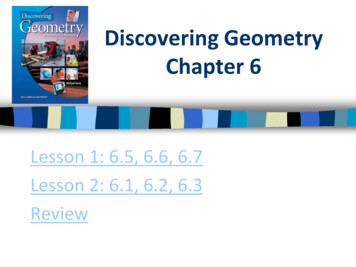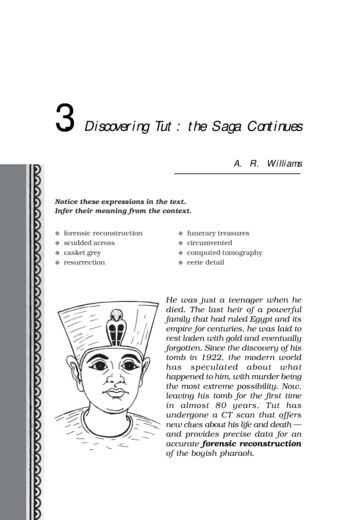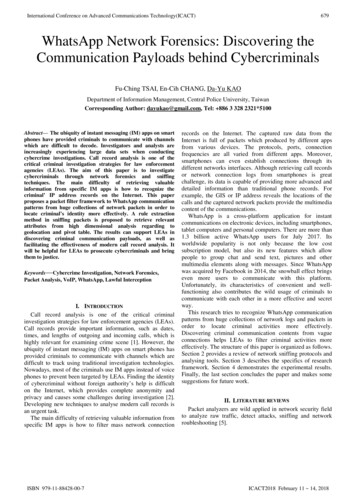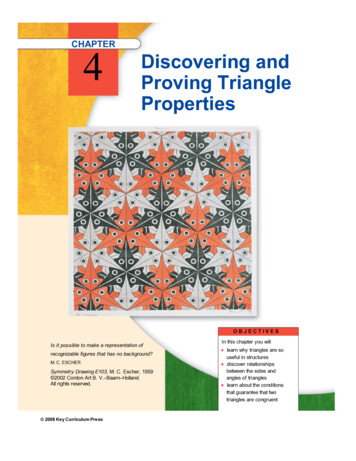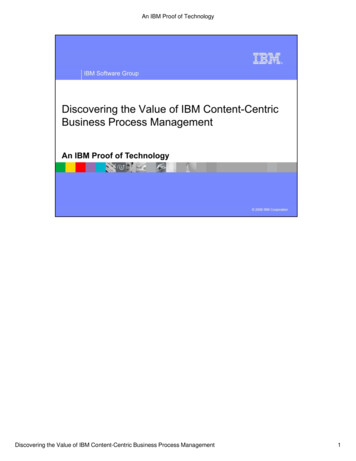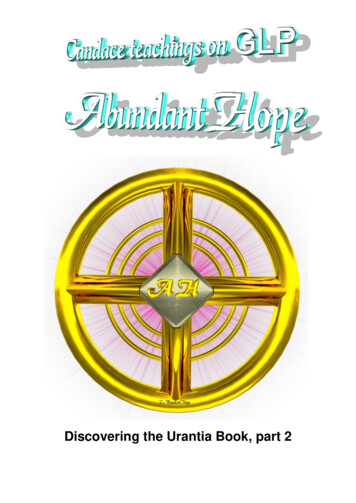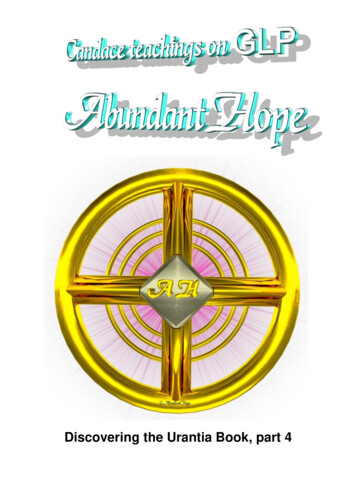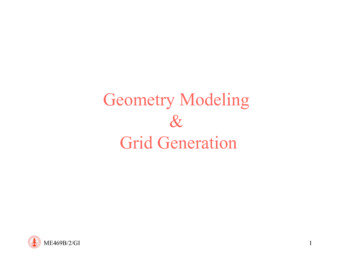
Transcription
DG4GP 905 fm.qxd12/14/061:52 PMPage iDiscoveringGeometryAn Investigative ApproachA Guide for Parents
DG4GP 905 fm.qxd12/14/061:52 PMPage iiTeacher’s Materials Project Editor: Elizabeth DeCarliEditors: Andres Marti, Ladie Malek, Kendra LockmanProject Administrator: Brady GoldenContributing Writers: Larry Copes, Jennifer North MorrisProject Manager: Lori Hazzard, ICC Macmillan Inc.Editorial Production Manager: Christine OsborneProduction Editor: Holly RudelitschProduction Supervisor: Ann RothenbuhlerProduction Coordinator: Jennifer YoungText Designer: Jenny SomervilleComposition, Technical Art, Prepress: ICC Macmillan Inc.Textbook Product Manager: James RyanExecutive Editor: Casey FitzSimonsPublisher: Steven Rasmussen 2008 by Key Curriculum Press. All rights reserved.Limited Reproduction PermissionThe publisher grants the teacher whose school has adopted Discovering Geometry,and who has received Discovering Geometry: An Investigative Approach, A Guidefor Parents as part of the Teaching Resources package for the book, the right toreproduce material for use in his or her own classroom. Unauthorized copying ofDiscovering Geometry: An Investigative Approach, A Guide for Parents constitutescopyright infringement and is a violation of federal law.TMThe Discovering Mathematics logo is a trademark of Key Curriculum Press. Allother registered trademarks and trademarks in this book are the property of theirrespective holders.Key Curriculum Press1150 65th StreetEmeryville, CA 94608510-595-7000editorial @keypress.comwww.keypress.comPrinted in the United States of America10 9 8 7 6 5 4 3 2 113 12 11 10 09 08 07 06ISBN 978-1-55953-905-0
DG4GP 905 fm.qxd12/14/061:52 PMPage iiiContentsThe Discovering Geometry Approach to LearningWorking with Your Studentix. . . . . . . . . . . . . . . . . . . . . . . . . . . . . . . . . . . . . . . . .Overview of Topics in Discovering GeometryChapter 0: Geometric Artv. . . . . . . . . . . . . . . . . . . . . . . . . . . . . . . . . . . . . . . . . . .xii. . . . . . . . . . . . . . . . . . . . . . . . . . . . . . . . . . . . . . . . . . . .Content Summary . . . . . . . . . . . . . . . . . . .Summary Problem . . . . . . . . . . . . . . . . . . .Chapter 0 Review Exercises . . . . . . . . . . .Solutions to Chapter 0 Review ExercisesChapter 1: Introducing Geometry1. . . . . . . . . . . . . . . . . . . . . . . . . . . . .1234. . . . . . . . . . . . . . . . . . . . . . . . . . . . . . . . . . . .5Content Summary . . . . . . . . . . . . . . . . . . .Summary Problem . . . . . . . . . . . . . . . . . . .Chapter 1 Review Exercises . . . . . . . . . . .Solutions to Chapter 1 Review ExercisesChapter 2: Reasoning in Geometry. . . . . . . . . . . . . . . . . . . . . . . . . . . . . . . . . . . . . . . . . . . . . . . . . . . . . . . . . . . . . . . . . . . . . . . . . . . . . . . . . . . . . . . . . . . . . . . . . . . . . . . . . . . . . . . . .5678. . . . . . . . . . . . . . . . . . . . . . . . . . . . . . . . . .9Content Summary . . . . . . . . . . . . . . . . . . .Summary Problem . . . . . . . . . . . . . . . . . . .Chapter 2 Review Exercises . . . . . . . . . . .Solutions to Chapter 2 Review Exercises. . . . . . . . . . . . . . . . . . . . . . . . . . . . . . . . . . . . . . . . . . . . . . . . . . . . . . . . . . . . . . . . . . . . . . . . . . . . . . . . . . . . .9101112. . . . . . . . . . . . . . . . . . . . . . . . . . . . . . . . . . . . . . . . . . . . . . . . . . . . . . . . . . . . . . . . . . . . . . . . . . . . . . . . . . . . . . . . . . . . . . . . . . . . . . . . . . . . . .Chapter 3: Using Tools of Geometry . . . . . . . . . . . . . . . . . . . . . . . . . . . . . . . . . 13Content Summary . . . . . . . . . . . . . . . . . . .Summary Problem . . . . . . . . . . . . . . . . . . .Chapter 3 Review Exercises . . . . . . . . . . .Solutions to Chapter 3 Review Exercises. . . . . . . . . . . . . . . . . . . . . . . . . . . . . . . . . . . . . . . . . . . . . . . . . . . . . . . . . . . . . . . . . . . . . . . . . . . . . . . . . . . . . . . . . . . . . . . . . . . . . . . . . . . . .Chapter 4: Discovering and Proving Triangle PropertiesContent Summary . . . . . . . . . . . . . . . . . . .Summary Problem . . . . . . . . . . . . . . . . . . .Chapter 4 Review Exercises . . . . . . . . . . .Solutions to Chapter 4 Review Exercises. . . . . . . . . . . .17. . . . . . . . . . . . . . . . . . . . . . . . . . . .17181920. . . . . . . . . . . . . . . . . . . . . . . . . . . . . . . . . . . . . . . . . . . . . . . . . . . . . . . . . . . . . . . . . . . . . . . . . . . . . . . . . .Chapter 5: Discovering and Proving Polygon PropertiesContent Summary . . . . . . . . . . . . . . . . . . .Summary Problem . . . . . . . . . . . . . . . . . . .Chapter 5 Review Exercises . . . . . . . . . . .Solutions to Chapter 5 Review Exercises13141516. . . . . . . . . . . .21. . . . . . . . . . . . . . . . . . . . . . . . . . . .21212324. . . . . . . . . . . . . . . . . . . . . . . . . . . . . . . . . . . . . . . . . . . . . . . . . . . . . . . . . . . . . . . . . . . . . . . . . . . . . . . . . .iii
DG4GP 905 fm.qxd12/19/067:53 PMPage ivChapter 6: Discovering and Proving Circle PropertiesContent Summary . . . . . . . . . . . . . . . . . . .Summary Problem . . . . . . . . . . . . . . . . . . .Chapter 6 Review Exercises . . . . . . . . . . .Solutions to Chapter 6 Review Exercises. . . . . . . . . . . . . . .25. . . . . . . . . . . . . . . . . . . . . . . . . . . .25252728. . . . . . . . . . . . . . . . . . . . . . . . . . . . . . . . . . . . . . . . . . . . . . . . . . . . . . . . . . . . . . . . . . . . . . . . . . . . . . . . . .Chapter 7: Transformations and Tessellations. . . . . . . . . . . . . . . . . . . . . . .29. . . . . . . . . . . . . . . . . . . . . . . . . . . . . . . . . . . . . . . . . . . . . . . . . . . . . . .29303132. . . . . . . . . . . . . . . . . . . . . . . . . . . . . . . . . . . . . . . . . . . . . . . . . . . . .33Content Summary . . . . . . . . . . . . . . . . . . .Summary Problem . . . . . . . . . . . . . . . . . . .Chapter 7 Review Exercises . . . . . . . . . . .Solutions to Chapter 7 Review ExercisesChapter 8: AreaContent Summary . . . . . . . . . . . . . . . . . . .Summary Problem . . . . . . . . . . . . . . . . . . .Chapter 8 Review Exercises . . . . . . . . . . .Solutions to Chapter 8 Review ExercisesChapter 9: The Pythagorean Theorem. . . . . . . . . . . . . . . . . . . . . . . . . . . . . . . . . . . . . . . . . . . . . . . . . . . . . . .33343536. . . . . . . . . . . . . . . . . . . . . . . . . . . . . .37Content Summary . . . . . . . . . . . . . . . . . . .Summary Problem . . . . . . . . . . . . . . . . . . .Chapter 9 Review Exercises . . . . . . . . . . .Solutions to Chapter 9 Review ExercisesChapter 10: Volume. . . . . . . . . . . . . . . . . . . . . . . . . . . . . . . . . . . . . . . . . . . . . . . . . . . . . . . . . . . . . . . . . . . . . . . . . . . . . . . . . . . . . . . . . . . . . . . . . . . . . . . . . . . . . . . . . . . . . . . . . . . . . . . . . . . . . . . .37383940. . . . . . . . . . . . . . . . . . . . . . . . . . . . . . . . . . . . . . . . . . . . . . . . .41. . . . . . . . . . . . . . . . . . . . . . . . . . . . . . . . . . . . . . . . . . . . . . . . . . . . . . . . . . . . . . . . . . . . . . . . . . . . . . . . . .Content Summary . . . . . . . . . . . . . . . . . . . .Summary Problem . . . . . . . . . . . . . . . . . . . .Chapter 10 Review Exercises . . . . . . . . . . .Solutions to Chapter 10 Review ExercisesChapter 11: Similarity. . . . . . . . . . . . . . . . . . . . . . . . . . .41424344. . . . . . . . . . . . . . . . . . . . . . . . . . . . . . . . . . . . . . . . . . . . . .45Content Summary . . . . . . . . . . . . . . . . . . . .Summary Problem . . . . . . . . . . . . . . . . . . . .Chapter 11 Review Exercises . . . . . . . . . . .Solutions to Chapter 11 Review ExercisesChapter 12: Trigonometry. . . . . . . . . . . . . . . . . . . . . . . . . . . . . . . . . . . . . . . . . . . . . . . . . . . . . . . . . . . . . . . . . . . . . . . . . . . . . . . . . . . . . . . . . . . . . . . . . . . . . . . . .45464748. . . . . . . . . . . . . . . . . . . . . . . . . . . . . . . . . . . . . . . . . .49Content Summary . . . . . . . . . . . . . . . . . . . . .Summary Problem . . . . . . . . . . . . . . . . . . . .Chapter 12 Review Exercises . . . . . . . . . . .Solutions to Chapter 12 Review Exercises. . . . . . . . . . . . . . . . . . . . . . . . . . . . . . . . . . . . . . . . . . . . . . . . . . . . . . . . . . . . . . . . . . . . . . . . . . . . . . . . . . . . . . . . . . . . . . . . . . . . . . . . . . . . . . . . . . . . . . . . . . . . . . . . . . . . . . . . . . . . . . . . . . . . . . . . . .Chapter 13: Geometry as a Mathematical SystemContent Summary . . . . . . . . . . . . . . . . . . . . .Summary Problem . . . . . . . . . . . . . . . . . . . .Chapter 13 Review Exercises . . . . . . . . . . .Solutions to Chapter 13 Review Exercisesiv49. 50. 51. 52. . . . . . . . . . . . . . . . . . . . . . . . . . . . . . . . . . . . . . . . . . . . .53. 54. 55. 56. . . . . . . . . . . . . . . . . . . . . . . . . . . . . . . . . . . . . . . . . . . . . . . . . . . . . . . . . . . . . . . . . . . . . . . . . . . . . . . . . . . . . . . . . . . . . . . . . . . . . .53
DG4GP 905 fm.qxd12/14/061:52 PMPage vThe Discovering GeometryApproach to LearningDiscovering Geometry: An Investigative Approach covers the topics you wouldexpect from a geometry course, but the teaching style as well as the learningexperience might be different from what you remember from your own highschool geometry course.In the past, and perhaps in your own school experience, geometry was aboutmemorizing a set of postulates and proving a long list of theorems, not aboutunderstanding properties of shapes or solving practical problems. For example,you might recognize this scenario: After going over the homework, your teacherintroduced a new theorem, went over a proof of the theorem, and showed how touse the theorem to solve a problem. Then you worked alone with paper andpencil and practiced solving problems of the same type. For homework, youworked on more problems of the same type and tried to write a proof related tothe new theorem. The next day, the class went through that same process with anew theorem. At some point, you took a test. You had to remember the theoremsand figure out what theorem to use for each problem. If you did well on all thetests, you were “good at math.” If you didn’t do well, you might have thought you“just weren’t good at it.”Many students cannot succeed in such an environment. When learning focuses onmechanical manipulations, students are limited in their understanding. They don’tknow when to apply a particular problem-solving strategy. They don’t come awayfrom their math course with a set of ideas that weave together into “the bigpicture.” They doubt that mathematics will be relevant to their careers and theydon’t see what others like about it. Even students who pass are reluctant tocontinue on in mathematics. Some develop “math phobia”—the fear of math—and avoid courses in science or business that require math. Ultimately, their fearlimits their career choices and earning potential.But all students can learn math better, have a good time doing it, and come awaywith an appreciation of its value as a tool for science, business, and everydaylife. Discovering Geometry is a program that helps all students reach a deepunderstanding of math by encouraging them to investigate interesting problemsin cooperative groups, use technology where appropriate, and practice usingproblem-solving skills to make tough problems manageable.All Students BenefitMichael Serra, the author of Discovering Geometry, taught geometry for 32 years.He knows from his own teaching experience that all students can experience moresuccess in mathematics. When the focus is on understanding concepts andreasoning strategies instead of just memorizing formulas and theorems, studentswho have previously been identified as having concentration, attention, andmemory issues can be more successful. Passive or reluctant students will learn tocommunicate better.To say that all students can learn geometry does not mean the course has beenwatered down. In fact, even very successful math students will find they arechallenged, learn more, and remember longer with the Discovering Geometryv
DG4GP 905 fm.qxd12/14/061:52 PMPage viapproach. That’s because the concepts and methods are not isolated from realworld applications or from previously learned ideas or from information they aregetting in other classes. The mathematics that students study is closer to what isneeded by both students seeking employment after high school and studentspreparing to attend college.Deep Understanding Is ImportantIn your own math classes, you might have been told: “Just do it—don’t ask why.”But there are logical reasons behind mathematical methods and ideas, and thepeople who understand these reasons succeed at math and, ultimately, at scienceand business. Discovering Geometry helps more students understand these reasons.Because the concepts make sense to students, students remember the methods (orreinvent them if they’ve forgotten them) and can apply them to new problems.To help develop that kind of flexible understanding, Discovering Geometry offersa more visual approach, with clearer and more frequent illustrations andphotographs, and the use of text captions to lead students through examples.Discovering Geometry also acknowledges the need for a gradual development ofmathematical ideas. Students are helped to see where the text is leading, and fullblown explanations are delayed until all the groundwork is laid. Once a topic hasbeen made part of what students are expected to know, it is reviewed and referredto again whenever appropriate. Understanding the math can make the math morefun for students, will bolster thei
Discovering Geometry: An Investigative Approach covers the topics you would expect from a geometry course, but the teaching style as well as the learning experience might be different from what you remember from your own high school geometry course. In the past, and perhaps in your own school experience, geometry was about
